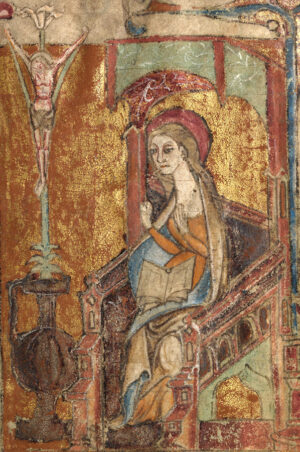EASTER AND THE LILY CRUCIFIX
They are everywhere. In the supermarket. In big box stores. In churches and the most modest flower shop. I can usually smell them before I see them. What am I talking about? Easter lilies. We’ll see and smell them in our sanctuary on Easter morning. But why have these glorious, gorgeous, showy white lilies become so closely associated with Easter?
The most obvious and common explanation is that the lily’s blossom bursts forth from a bulb that’s been buried in the soil. So it’s an obvious metaphor for Jesus’ death and resurrection. As Natalie Sleeth’s song of resurrection, “In the Bulb There is a Flower” says,
In the bulb there is a flower; In the seed, an apple tree . . . .
In the cold and snow of winter there’s a spring that waits to be: Unrevealed until its season, something God alone can see.
There’s much more to the lily’s association with Easter than this most obvious and oft repeated one, however
In the early church, legends around the lily were widely circulated. In the Garden of Eden, Eve’s remorseful tears were believed to have formed lilies upon contact with the earth. White lilies were believed to have grown from the spots where Jesus’s blood and tears fell into the earth after his agony in the Garden of Gethsemane. Other legends said that white lilies sprung up on Golgotha, the location of Jesus Christ’s crucifixion. But the biblical person most closely associated with the white lily was Mary. It was even commonly called the “Madonna lily.” And artists frequently included its image in paintings or sculptures of Mary. An especially noteworthy artistic convention of the Annunciation is to show the archangel Gabriel presenting Mary with a lily and her acceptance of the flower as a visual representation of her “yes” to God.
Since the Annunciation’s observance always falls on March 25, which is exactly 9 months before Christmas day (even those medieval monks and bishops knew how to count the days between conception and birth!), the Annunciation typically occurs close to Holy Week and Easter. So gradually Mary and her lily made their way into depictions of the Crucifixion. The same lily present at Gabriel’s annunciation of Jesus’ conception springs up at the foot of the cross. Just as the arc of Jesus’ life begins with Gabriel presenting a flowering lily to Mary it ends with flowering lilies at the foot of the cross.
All these images and associations converged it something almost unique to medieval English-speaking peoples: The Lily Crucifix. In the Lily Crucifix the story of Jesus’ conception is grafted onto the story of his death and resurrection. Jesus is portrayed as being crucified on a lily-shaped cross. About 20 such representations of the Lily Crucifix have survived across Britain. They are found on everything from stained glass windows to tomb sculptures, from wall paintings to manuscript embellishments. Here is a lovely example from a 14th-century Welsh manuscript illustration.

Mary is seated before a tiny angel Gabriel wearing green and red. Over Mary’s head is a green canopy. And, sprouting from an urn, which looks vaguely reminiscent of those potted urns with which we still decorate our churches at Easter, is a crucifix that has become a lily stem topped by a flowering white lily just above Jesus’ bloodied head. At the foot of this cross, just as it sprouts from the urn, you can even see the leaves that adorn the stems of present-day Easter lilies.
This particular manuscript’s Lily Crucifix is inviting both Mary and us to contemplate the whole arc of Jesus’ life from conception to crucifixion and ultimately to resurrection. For the lily on which he is crucified bears a blossom that bursts forth from a bare root sunk into the soil, symbolizing the resurrection. In our Welsh manuscript illustration, the urn from which the flowering bulb emerges closely resembles a funeral urn. The totality of the Good News of Jesus Christ is condensed into one simple but richly evocative image. In the Lily Crucifix we are invited to contemplate the whole arc of Jesus life – the joy of Incarnation, the grief of crucifixion, and the wonderous power of resurrection. It summons up every biblical story from Gabriel’s annunciation to Simeon’s prophecy that Mary’s child will pierce her heart to the agony of the cross and the mystery of resurrection.
This Easter Sunday we’ll have Easter lilies in our sanctuary. We will also, I’m told (this being the first Easter I join with you in worship), have a cross in our sanctuary on which we are invited to place flowers.
So when we worship this Easter Sunday, let’s remember what a rich, ancient, and multi-layered set of meanings our Easter lilies and our flower cross have. Our lilies and Easter cross are part of ancient devotional and contemplative practices whose antiquity and deeper significance we have largely forgotten yet still shape our spiritual lives in the 21st century. Through our Easter Lilies, Christians from nearly three-quarters of a millennium ago are still inviting us to celebrate with them that.
In the bulb there is a flower; In the seed, an apple tree . . . .
In the cold and snow of winter there’s a spring that waits to be:
Unrevealed until its season, something God alone can see.
In our end is our beginning, in our time, infinity.
In our doubt there is believing; in our life, eternity.
In our death a resurrection; at last, a victory.
Unrevealed until its season, something God alone can see.
Happy Easter!
Pastor Thomas
